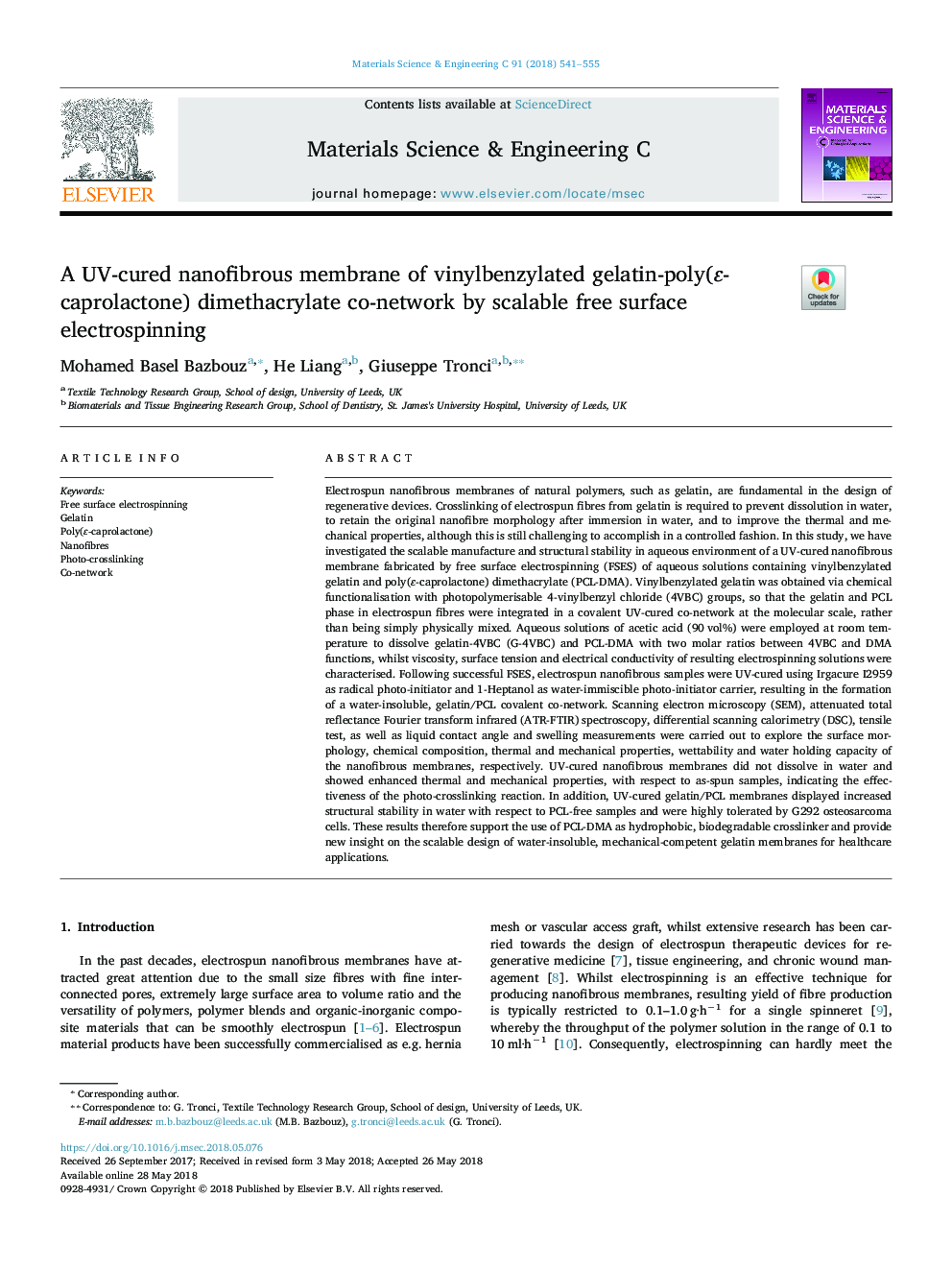| کد مقاله | کد نشریه | سال انتشار | مقاله انگلیسی | نسخه تمام متن |
|---|---|---|---|---|
| 7866094 | 1509130 | 2018 | 15 صفحه PDF | دانلود رایگان |
عنوان انگلیسی مقاله ISI
A UV-cured nanofibrous membrane of vinylbenzylated gelatin-poly(É-caprolactone) dimethacrylate co-network by scalable free surface electrospinning
دانلود مقاله + سفارش ترجمه
دانلود مقاله ISI انگلیسی
رایگان برای ایرانیان
کلمات کلیدی
موضوعات مرتبط
مهندسی و علوم پایه
مهندسی مواد
بیومتریال
پیش نمایش صفحه اول مقاله

چکیده انگلیسی
Electrospun nanofibrous membranes of natural polymers, such as gelatin, are fundamental in the design of regenerative devices. Crosslinking of electrospun fibres from gelatin is required to prevent dissolution in water, to retain the original nanofibre morphology after immersion in water, and to improve the thermal and mechanical properties, although this is still challenging to accomplish in a controlled fashion. In this study, we have investigated the scalable manufacture and structural stability in aqueous environment of a UV-cured nanofibrous membrane fabricated by free surface electrospinning (FSES) of aqueous solutions containing vinylbenzylated gelatin and poly(É-caprolactone) dimethacrylate (PCL-DMA). Vinylbenzylated gelatin was obtained via chemical functionalisation with photopolymerisable 4-vinylbenzyl chloride (4VBC) groups, so that the gelatin and PCL phase in electrospun fibres were integrated in a covalent UV-cured co-network at the molecular scale, rather than being simply physically mixed. Aqueous solutions of acetic acid (90â¯vol%) were employed at room temperature to dissolve gelatin-4VBC (G-4VBC) and PCL-DMA with two molar ratios between 4VBC and DMA functions, whilst viscosity, surface tension and electrical conductivity of resulting electrospinning solutions were characterised. Following successful FSES, electrospun nanofibrous samples were UV-cured using Irgacure I2959 as radical photo-initiator and 1-Heptanol as water-immiscible photo-initiator carrier, resulting in the formation of a water-insoluble, gelatin/PCL covalent co-network. Scanning electron microscopy (SEM), attenuated total reflectance Fourier transform infrared (ATR-FTIR) spectroscopy, differential scanning calorimetry (DSC), tensile test, as well as liquid contact angle and swelling measurements were carried out to explore the surface morphology, chemical composition, thermal and mechanical properties, wettability and water holding capacity of the nanofibrous membranes, respectively. UV-cured nanofibrous membranes did not dissolve in water and showed enhanced thermal and mechanical properties, with respect to as-spun samples, indicating the effectiveness of the photo-crosslinking reaction. In addition, UV-cured gelatin/PCL membranes displayed increased structural stability in water with respect to PCL-free samples and were highly tolerated by G292 osteosarcoma cells. These results therefore support the use of PCL-DMA as hydrophobic, biodegradable crosslinker and provide new insight on the scalable design of water-insoluble, mechanical-competent gelatin membranes for healthcare applications.
ناشر
Database: Elsevier - ScienceDirect (ساینس دایرکت)
Journal: Materials Science and Engineering: C - Volume 91, 1 October 2018, Pages 541-555
Journal: Materials Science and Engineering: C - Volume 91, 1 October 2018, Pages 541-555
نویسندگان
Mohamed Basel Bazbouz, He Liang, Giuseppe Tronci,